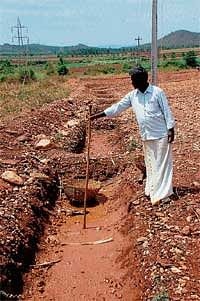

Bore wells would go dry, leaving people in dire strait, forcing them to trek miles to get water. Tired of this regular routine, some farmers decided to take up watershed development. Today these farmers show their farms proudly and explain the secret of their success.
“We never knew that digging canals in the farm can be so helpful. When learned people showed us the way, we adopted the technique and today we are happy,” says farmer Ramesh from Koracharahatti along with Kumar, another farmer who too has adopted the same technique.
“Koracharahatti went dry like many other villages. We would dig bore wells but the bores would go dry. We then thought of breaking this annual cycle and going in for permanent solution. We decided to collect running water and harvest stagnant water. This worked in our favour and today here we are without any water problem,” they say.
Due to this recharge technique, they say that the water level in the bore wells in the village has increased and bore wells which had failed 7 years ago have water now. The villagers have shown that nothing is impossible if people come together to script a revolution.
Earlier the villagers of Koracharahatti used to grow Ragi, Jowar etc on their farm land. Since there were no canals or bund in their farmland all the rain water used to meet its natural seepage, corroding top fertile soil along with it. The situation had continued till the water shed department experts came to the village once and witnessed what was happening.
Soon Pragathi Watershed Development Committee was formed and with the help of Nabard and technical help from Bhoomi organisation, people took to water harvesting. With initial inhibitions like whether harvesting will be of any help or not, villagers slowly gained confidence and plunged into it as though it was a revolution.
After collecting details on quantity of rainfall, direction of flow of water, water sources, speed of the flow of rainwater, size of land holding etc villagers constructed canals in slopes scientifically at prescribed distance. They built a sump behind the canals so that the rain water collected in the farm was collected and harvested. Believe it or not, villagers say that it was the principle deity of the village Kollapuradamma who had first said that the bore well belonging to Rajanna, a villager, which had failed many years ago had been revived!
Villagers inform that Rajanna who had faced loss in farming had come to Goddess Kollapuradamma to seek her permission to dig another bore in the farm land. It was then that the goddess said that the existing borewell is recharged and hence there was no need for him to dig another bore. When Rajanna went back to the bore he found that there was 3 inch water in the bore.
So far the villagers have built 2500 cubic meters of canal and they are now into growing paddy on one side of the canal and planting trees on the other side. Many have started compost manure plant in their houses. They also have a plan of starting Koracharahatti dairy.
Koracharahati is a model for many other villages. It is a testimony for how people’s initiatives can bring success and change the entire face of a village and march the village on path of prosperity and well being.